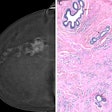Wednesday, November 29 | 11:20 a.m.-11:30 a.m. | SSK01-06 | Room E450A
A group from the University of Southern California will discuss the performance of a quantitative computer-aided detection (qCAD) software application that uses deep learning and artificial intelligence (AI) to improve mammography screening.The qCAD software from CureMetrix features deep-learning algorithms and is trained with known benign and malignant lesions detected on mammograms to classify lesions based on the probability of malignancy.
"Use of AI may eliminate many false-positive recalls from screening and reduce the percentage of benign breast biopsies," said Dr. Alyssa Watanabe from the university's Keck School of Medicine. "In addition, the CureMetrix CAD software could have potential benefits in workflow -- such as placing suspicious mammograms at the top of a worklist -- and for the earlier detection of breast cancers."
Watanabe and colleague conducted a comparative analysis of patients' screening and diagnostic 2D mammograms whereby tissue was biopsied based on suspicious calcifications. The analysis included more than 10,000 consecutive cases from three different institutions. Predictions of suspiciousness from qCAD were compared with the expert radiologists' reads.
Of some 400 cases sent to biopsy, approximately 75% were benign, with the remainder classified as malignant. The software detected all the confirmed cancer cases. If biopsy recommendations had been based on the algorithm, as many as 56% of the biopsies could have been avoided.
"Our results show that the artificial intelligence-based software outperformed the radiologists at three different institutions in classifying benign versus malignant lesions on mammograms," Watanabe told AuntMinnie.com. "We also show that there is a potential to reduce benign biopsies using artificial intelligence as a supplemental aid for mammographers."


















